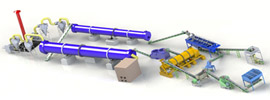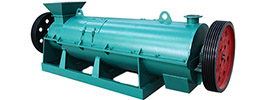The reaction granulation process of ammonium sulfate fertilizer in a granulator is a complex technology that combines chemical reactions with physical shaping. Its core lies in generating ammonium sulfate solution through a neutralization reaction and utilizing this solution as a binder to mix with other raw materials for granulation. Below is a detailed technical analysis:
Reaction Granulation Process of Ammonium Sulfate Fertilizer in a Granulator
The reaction granulation process of ammonium sulfate fertilizer in a granulator is a sophisticated technology that integrates chemical reactions with physical shaping. Its core lies in generating ammonium sulfate solution through a neutralization reaction and utilizing this solution as a binder to mix with other raw materials for granulation. Below is a detailed technical analysis:
I. Raw Material Preparation and Pretreatment
1. Raw Material Synthesis
-
Ammonia Water Preparation: Liquid ammonia is mixed with water in a specific ratio to produce ammonia water.
-
Sulfuric Acid Preparation: Sulfur or sulfur-bearing minerals undergo combustion and oxidation reactions to generate concentrated sulfuric acid.
-
Neutralization Reaction: Ammonia water reacts with sulfuric acid in a reactor through a neutralization reaction to produce ammonium sulfate solution:
H2SO4+2NH3→(NH4)2SO4
The reaction requires strict control of temperature (60-80°C) and pH to ensure complete reaction.
2. Pretreatment Process
- Evaporation and Concentration: The ammonium sulfate solution undergoes multi-stage evaporation to remove water and reach crystallization concentration.
- Cooling Crystallization: The concentrated solution is cooled, causing ammonium sulfate crystals to precipitate.
- Solid-Liquid Separation and Drying: Wet crystals are separated using a centrifuge and then dried with hot air until the moisture content is ≤1.0%.
II. Reaction Granulation Process in the Granulator
1. Chemical Granulation Method (Ammonium Acid Method)
KCl+(NH4)2SO4→(NH4,K)SO4(ammonium potassium sulfate complex salt)
| |
These complex salts form solid solutions, solidifying the particles. |
- Particle Growth: As the drum rotates, raw material powders are gradually entangled and kneaded into particles by the binder liquid, with a particle size distribution approaching a normal distribution.
2. Physical Extrusion Granulation Method
III. Control of Key Process Parameters
| Parameter |
Range/Requirement |
Function |
| Granulation Temperature |
60-80°C (to maintain liquid flowability) |
Promotes chemical reactions and prevents liquid solidification |
| Drying Temperature |
Inlet: 150-300°C, Outlet: 60-80°C |
Evaporates moisture and enhances particle strength |
| Reaction Pressure |
0.2-0.5 MPa (tubular reactor) |
Ensures rapid mixing and reaction of ammonia and sulfuric acid |
| Binder Usage |
3%-5% (polyformaldehyde solution) |
Increases particle hardness (>25N) and reduces caking rate |
| Raw Material Ratio |
Ammonium sulfate:Urea:Gypsum = 90-95:3-5:2-5 |
Optimizes particle nutrient content and physical properties |
IV. Post-Treatment and Quality Control
- Drying and Cooling: Particles are dried in a counter-current rotary kiln dryer and then cooled with cold air to below 50°C to prevent caking.
- Screening and Recycling: Unqualified particles (too large or too small) are returned to the granulator for reprocessing, improving raw material utilization.
- Anti-Caking Treatment: Finished particles are coated with an anti-caking agent (such as polyformaldehyde solution) in an anti-caking device to extend storage life.
V. Process Advantages and Application Scenarios
VI. Precautions
- Side Reaction Control: Avoid excessive reaction between ammonium sulfate and raw materials like potassium chloride to prevent the formation of low-melting-point substances that affect particle stability.
- Equipment Maintenance: Regularly clean crystalline deposits in the tubular reactor to prevent blockage; inspect the ammonia gas distributor to ensure uniform mixing.
- Environmental Requirements: Exhaust gas from drying must undergo sulfuric acid washing to absorb ammonia before being discharged in compliance with standards.
Through the above process, ammonium sulfate fertilizer can achieve efficient and stable granular production, meeting the agricultural demand for fertilizers with balanced nutrients and excellent physical properties.
 Send us a Email
Send us a Email Wulong Industrial Cluster
Wulong Industrial Cluster Have any question?
Have any question?


















